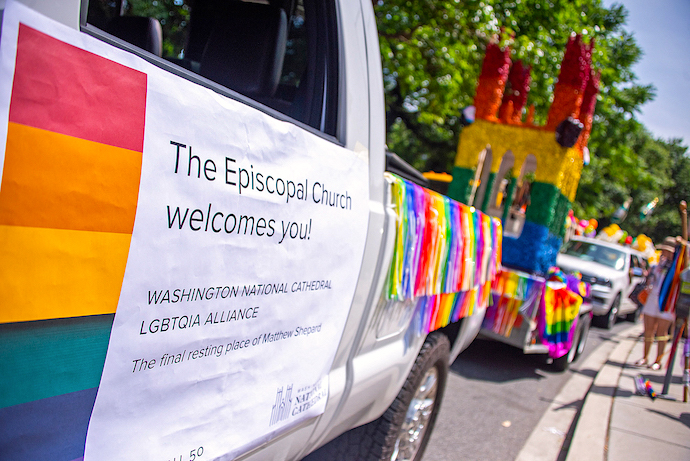When representatives of The Episcopal Church gather in Baltimore for the denomination’s General Convention taking place from July 8-11, they’ll be asked to consider a proposed overhaul to the church’s sexual violence prevention policy.
Currently, Episcopal canon law requires those preparing for ordination to demonstrate competencies in the “prevention of sexual misconduct.” The proposed changes would strike that requirement. Instead, ordinands would need to demonstrate the loftier-sounding, but more nebulous, ability to “form communities that understand and welcome diverse experiences of gender and sexuality, manifest safe and appropriate boundaries, and implement strategies to prevent sexual misconduct.”
The intent is to underscore “the importance of providing places for inclusion and support for those who have experienced rejection, shaming, and violence”—in particular, members of the LGBTQ+ community—which sounds like a welcome and refreshing change.
But there’s a problem.
Gender and sexual minorities don’t just experience rejection, shaming, and violence outside Episcopal churches—they experience them within Episcopal churches at alarmingly high rates, too. And the denomination’s structures (canon law included) have consistently failed to protect them.
New data reveals the scope of the abuse crisis
Buried deep in the Reports to the General Convention are the results of a survey, conducted in 2020, that quantifies the violence epidemic. Based on a similar survey conducted in 2017 amongst United Methodists in the United States, it contributes to the “truth telling” element of a planned truth-and-reconciliation process on gender and sexual abuse in Episcopal spaces.
And the truth is horrifying.
Of the more than 2400 responses collected, 475 (20%) are from cisgender LGB Episcopalians. Nearly 40% of these—189 individuals—reported being the targets of inappropriate jokes and comments; 29.9%—82 individuals—of inappropriate touching; and a further 14.9%—71 individuals—of attempted fondling or kissing.
The survey also uncovered alarming rates of attempted assault, including attempted rape. Among cisgender LGB respondents 5.3%—25 individuals—disclosed being the targets of such misconduct, as compared to 2.4% of cisgender heterosexual respondents (a further 44 victims). The survey doesn’t break down the data on completed sexual assaults or rapes by victims’ sexual orientation. But in total, a staggering 3.5% of all respondents—86 individuals—identified themselves as being the victims of such violence in an Episcopal church (47 individuals), school (22 individuals), or workplace (17 individuals).
The percentages are even more striking when looking at the data for transgender and non-binary respondents.
Nearly 75% of Episcopal clergy who identify as such reported being the victims of sexual misconduct of some kind, as did 100% of those employed in non-ordained roles and 50% of congregation members.
The survey also found that transgender and non-binary respondents were victimized at higher rates than their cisgender counterparts across a range of inappropriate behaviours. To cite just one example: 39% disclosed inappropriate touching or closeness, compared to 27.2% of cisgender women and 16.4% of cisgender men.
The survey organizers caution that the data they collected is unlikely to be representative of Episcopalians as a whole. “Because victims/survivors are more likely to complete a survey on [their victimization],” they argue in the preface to their report, the percentage of respondents reporting gender and sexual violence “is surely higher than it would be if all Episcopalians had participated.”
To be sure, the data isn’t based on a random sample size and therefore isn’t statistically representative.
The number of individuals reporting victimization in Episcopal spaces is alarming nonetheless.
However, I would argue the data is more likely to under- than to overestimate the scope of the abuse that occurs. To see why, the survey results must be interpreted in light of the Episcopal Church’s larger culture of inaction around sexual violence.
See no evil, hear no evil…
LGBTQ+ Episcopalians, and especially those who identify under the transgender and nonbinary umbrella, were far more likely than their cisgender and heterosexual counterparts to cite a fear that nothing would be done or that they’d be retaliated against as their top reasons not to report instances of sexual abuse to denominational authorities.
Those fears are, unfortunately, well-founded.
Of those victims who did report their victimization to Episcopal leaders, the number one assessment from both trans/non-binary and cisgender respondents was that “little or no change” came about as a result. 20.6% of transgender and non-binary survivors reported that they simply left the church altogether. By comparison, “only” 10.7% of cisgender women felt they had to leave. (Curiously, there’s no data on this front for LGB-identified Episcopalians.)
It would be difficult to come to any conclusion other than that the culture of The Episcopal Church is one in which “problem” victims who speak out are either ignored or made to go away. It’s a wonder any abuser survivors responded to the denomination’s survey at all.
The dark side of inclusive Christianity
The data the survey nonetheless yielded would be sobering in any context. But it’s a particularly striking look at on-the-ground realities in Episcopal churches because the denomination rests so much of its brand identity on being a safe haven for gender and sexual refugees from more conservative traditions.
“We have a legacy of inclusion,” the denomination’s website proudly states; a legacy that began with The Episcopal Church’s General Convention formally affirming, in 1976, that “homosexual persons are children of God who have a full and equal claim with all other persons upon the love, acceptance, and pastoral concern and care of the Church.”
Indeed, in 2004, the denomination became the first in the Anglican Communion to consecrate an openly gay bishop, Gene Robinson. Last year, however, Bishop Robinson inexplicably told LGBTQ+ Episcopalians, incensed that the denomination had invited noted-homophobe Max Lucado to preach from the Episcopal-run National Cathedral, that “we’ve won.”
A month later, The Episcopal Church responded to a Vatican decree prohibiting Roman Catholic priests from blessing same-sex unions by tweeting “The Episcopal Church Welcomes You.” The tweet was deleted within an hour following a backlash from Twitter users who pointed out that there are still parts of the denomination that do not, in fact, welcome LGBTQ+ members.
Marketing itself (however flat-footedly) as the progressive, welcoming face of American Christianity makes sense as a way of distinguishing The Episcopal Church on the religious landscape from the evangelical Right and its culture wars against gay marriage and transgender rights, among other conservative bugaboos. Disaffected with the latter? The Episcopal Church welcomes you.
Here’s the problem. This brand image is at odds with the fact that LGBTQ+ Episcopalians experience sexual victimization in Episcopal spaces at consistently higher rates than their cisgender and heterosexual counterparts. So in order to preserve that image, reports of abuse need to go away—preferably quietly.
The result is a culture of silence in which survivors aren’t heard, their stories aren’t acted upon, and abusers remain in positions of power to abuse again. The sort of meaningful change that would actually protect LGBTQ+ Episcopalians never occurs because that would mean acknowledging, publicly, that The Episcopal Church has a systemic abuse crisis in the first place.
The denomination can say what it likes about being a bastion of inclusivity. The fact is, it’s not safe for LGBTQ+ people. And finding more elaborate ways of talking about the prevention of sexual misconduct isn’t about to change that.





